Sustainable Approaches and CSR Strategies of Easyjet, Electrolux AB and Tesco
VerifiedAdded on 2023/06/08
|13
|3493
|393
AI Summary
This report discusses sustainable approaches and CSR strategies of Easyjet, Electrolux AB, and Tesco. It analyzes different approaches to CSR and measures success. It also includes a reflective report on key skills development, such as communication, problem-solving, and numeracy. The report is divided into two parts, with the first part covering sustainable approaches and the second part covering key skills development.
Contribute Materials
Your contribution can guide someone’s learning journey. Share your
documents today.
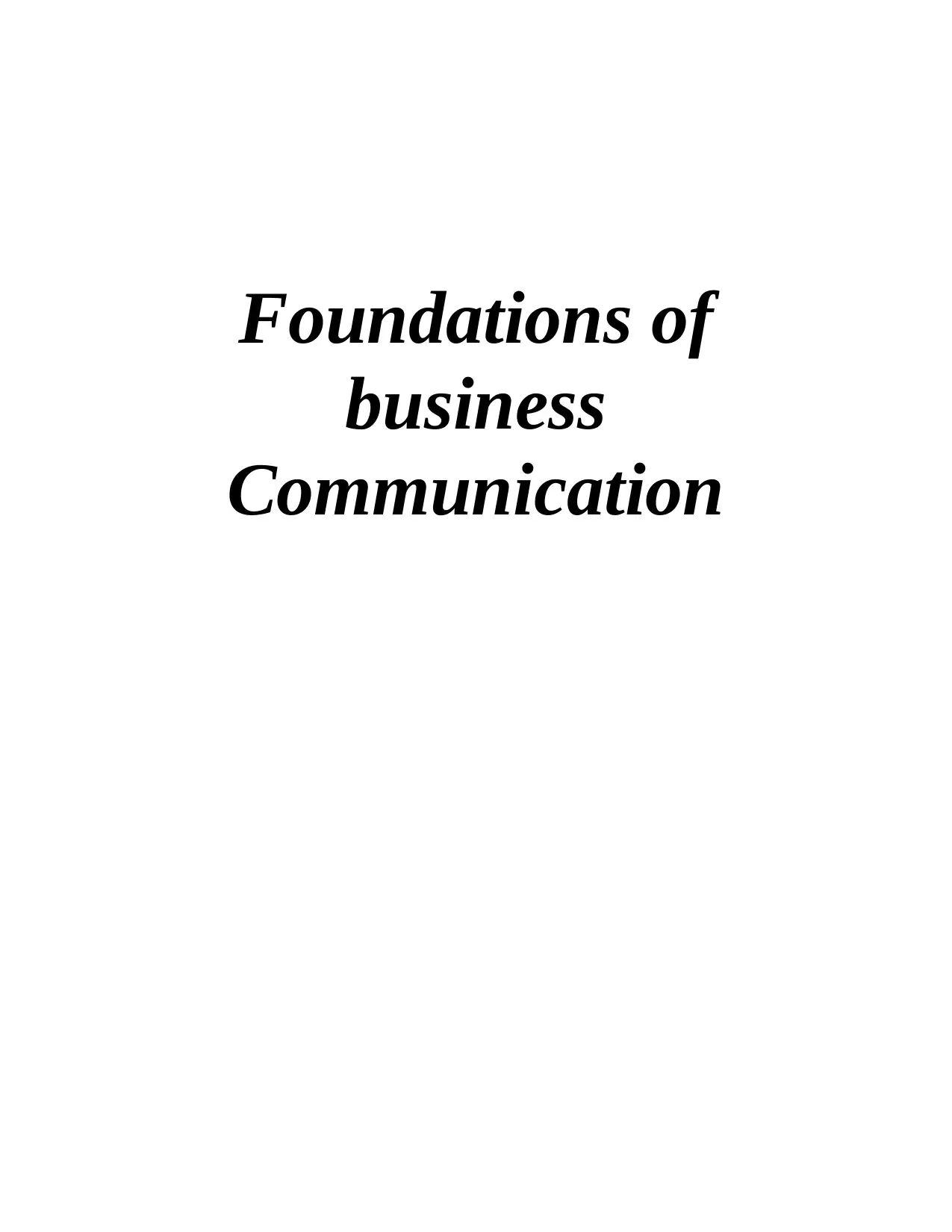
Foundations of
business
Communication
business
Communication
Secure Best Marks with AI Grader
Need help grading? Try our AI Grader for instant feedback on your assignments.
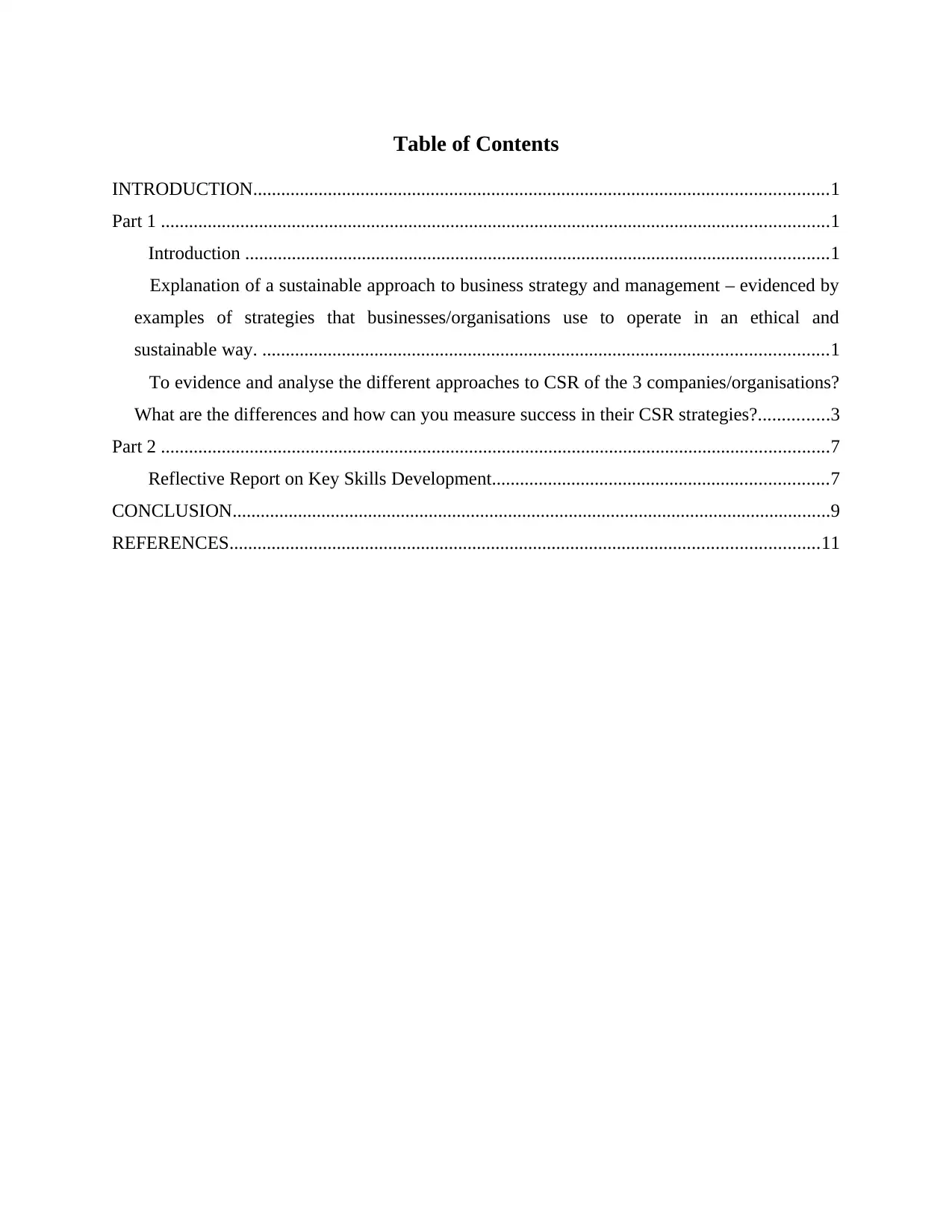
Table of Contents
INTRODUCTION...........................................................................................................................1
Part 1 ...............................................................................................................................................1
Introduction .............................................................................................................................1
Explanation of a sustainable approach to business strategy and management – evidenced by
examples of strategies that businesses/organisations use to operate in an ethical and
sustainable way. .........................................................................................................................1
To evidence and analyse the different approaches to CSR of the 3 companies/organisations?
What are the differences and how can you measure success in their CSR strategies?...............3
Part 2 ...............................................................................................................................................7
Reflective Report on Key Skills Development........................................................................7
CONCLUSION................................................................................................................................9
REFERENCES..............................................................................................................................11
INTRODUCTION...........................................................................................................................1
Part 1 ...............................................................................................................................................1
Introduction .............................................................................................................................1
Explanation of a sustainable approach to business strategy and management – evidenced by
examples of strategies that businesses/organisations use to operate in an ethical and
sustainable way. .........................................................................................................................1
To evidence and analyse the different approaches to CSR of the 3 companies/organisations?
What are the differences and how can you measure success in their CSR strategies?...............3
Part 2 ...............................................................................................................................................7
Reflective Report on Key Skills Development........................................................................7
CONCLUSION................................................................................................................................9
REFERENCES..............................................................................................................................11
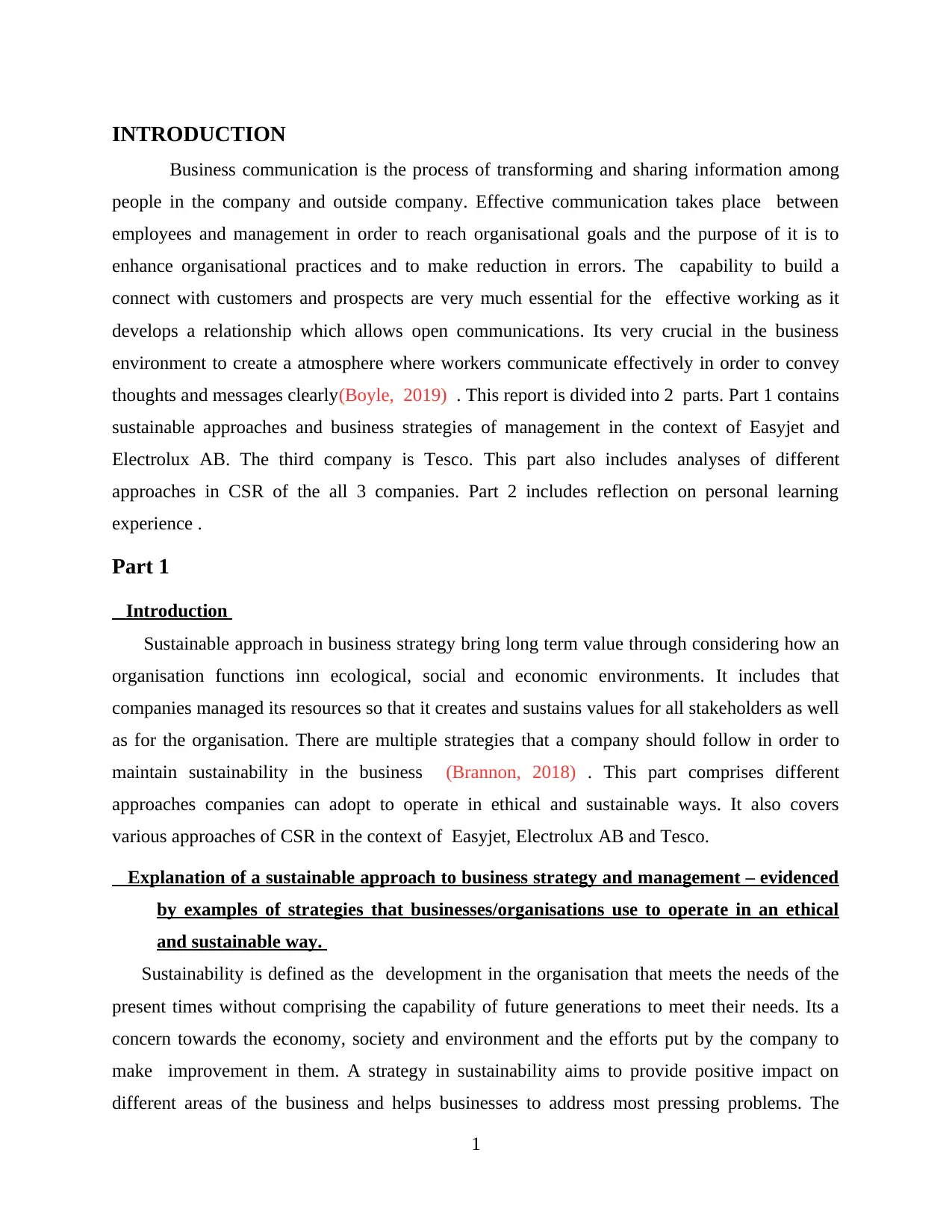
INTRODUCTION
Business communication is the process of transforming and sharing information among
people in the company and outside company. Effective communication takes place between
employees and management in order to reach organisational goals and the purpose of it is to
enhance organisational practices and to make reduction in errors. The capability to build a
connect with customers and prospects are very much essential for the effective working as it
develops a relationship which allows open communications. Its very crucial in the business
environment to create a atmosphere where workers communicate effectively in order to convey
thoughts and messages clearly(Boyle, 2019) . This report is divided into 2 parts. Part 1 contains
sustainable approaches and business strategies of management in the context of Easyjet and
Electrolux AB. The third company is Tesco. This part also includes analyses of different
approaches in CSR of the all 3 companies. Part 2 includes reflection on personal learning
experience .
Part 1
Introduction
Sustainable approach in business strategy bring long term value through considering how an
organisation functions inn ecological, social and economic environments. It includes that
companies managed its resources so that it creates and sustains values for all stakeholders as well
as for the organisation. There are multiple strategies that a company should follow in order to
maintain sustainability in the business (Brannon, 2018) . This part comprises different
approaches companies can adopt to operate in ethical and sustainable ways. It also covers
various approaches of CSR in the context of Easyjet, Electrolux AB and Tesco.
Explanation of a sustainable approach to business strategy and management – evidenced
by examples of strategies that businesses/organisations use to operate in an ethical
and sustainable way.
Sustainability is defined as the development in the organisation that meets the needs of the
present times without comprising the capability of future generations to meet their needs. Its a
concern towards the economy, society and environment and the efforts put by the company to
make improvement in them. A strategy in sustainability aims to provide positive impact on
different areas of the business and helps businesses to address most pressing problems. The
1
Business communication is the process of transforming and sharing information among
people in the company and outside company. Effective communication takes place between
employees and management in order to reach organisational goals and the purpose of it is to
enhance organisational practices and to make reduction in errors. The capability to build a
connect with customers and prospects are very much essential for the effective working as it
develops a relationship which allows open communications. Its very crucial in the business
environment to create a atmosphere where workers communicate effectively in order to convey
thoughts and messages clearly(Boyle, 2019) . This report is divided into 2 parts. Part 1 contains
sustainable approaches and business strategies of management in the context of Easyjet and
Electrolux AB. The third company is Tesco. This part also includes analyses of different
approaches in CSR of the all 3 companies. Part 2 includes reflection on personal learning
experience .
Part 1
Introduction
Sustainable approach in business strategy bring long term value through considering how an
organisation functions inn ecological, social and economic environments. It includes that
companies managed its resources so that it creates and sustains values for all stakeholders as well
as for the organisation. There are multiple strategies that a company should follow in order to
maintain sustainability in the business (Brannon, 2018) . This part comprises different
approaches companies can adopt to operate in ethical and sustainable ways. It also covers
various approaches of CSR in the context of Easyjet, Electrolux AB and Tesco.
Explanation of a sustainable approach to business strategy and management – evidenced
by examples of strategies that businesses/organisations use to operate in an ethical
and sustainable way.
Sustainability is defined as the development in the organisation that meets the needs of the
present times without comprising the capability of future generations to meet their needs. Its a
concern towards the economy, society and environment and the efforts put by the company to
make improvement in them. A strategy in sustainability aims to provide positive impact on
different areas of the business and helps businesses to address most pressing problems. The
1
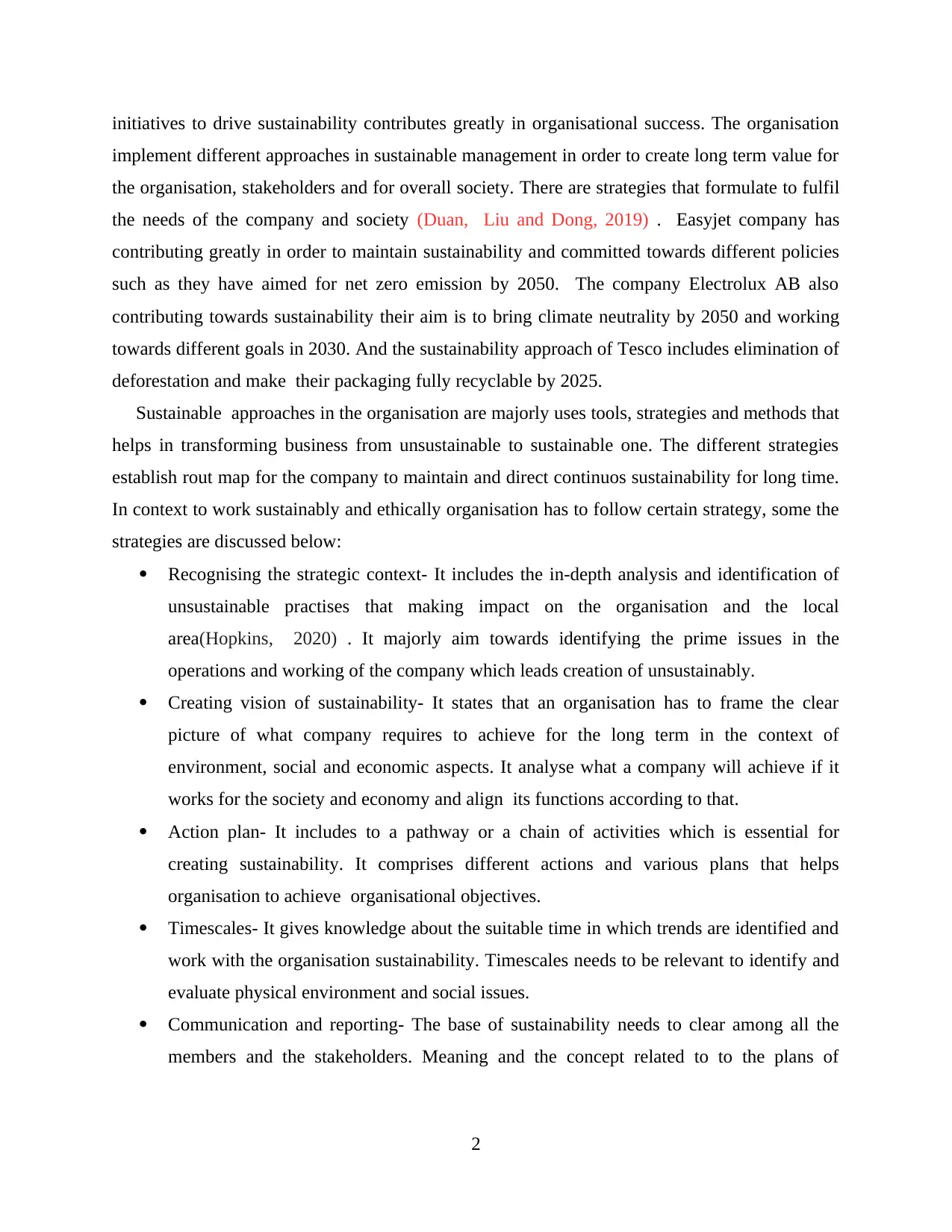
initiatives to drive sustainability contributes greatly in organisational success. The organisation
implement different approaches in sustainable management in order to create long term value for
the organisation, stakeholders and for overall society. There are strategies that formulate to fulfil
the needs of the company and society (Duan, Liu and Dong, 2019) . Easyjet company has
contributing greatly in order to maintain sustainability and committed towards different policies
such as they have aimed for net zero emission by 2050. The company Electrolux AB also
contributing towards sustainability their aim is to bring climate neutrality by 2050 and working
towards different goals in 2030. And the sustainability approach of Tesco includes elimination of
deforestation and make their packaging fully recyclable by 2025.
Sustainable approaches in the organisation are majorly uses tools, strategies and methods that
helps in transforming business from unsustainable to sustainable one. The different strategies
establish rout map for the company to maintain and direct continuos sustainability for long time.
In context to work sustainably and ethically organisation has to follow certain strategy, some the
strategies are discussed below:
Recognising the strategic context- It includes the in-depth analysis and identification of
unsustainable practises that making impact on the organisation and the local
area(Hopkins, 2020) . It majorly aim towards identifying the prime issues in the
operations and working of the company which leads creation of unsustainably.
Creating vision of sustainability- It states that an organisation has to frame the clear
picture of what company requires to achieve for the long term in the context of
environment, social and economic aspects. It analyse what a company will achieve if it
works for the society and economy and align its functions according to that.
Action plan- It includes to a pathway or a chain of activities which is essential for
creating sustainability. It comprises different actions and various plans that helps
organisation to achieve organisational objectives.
Timescales- It gives knowledge about the suitable time in which trends are identified and
work with the organisation sustainability. Timescales needs to be relevant to identify and
evaluate physical environment and social issues.
Communication and reporting- The base of sustainability needs to clear among all the
members and the stakeholders. Meaning and the concept related to to the plans of
2
implement different approaches in sustainable management in order to create long term value for
the organisation, stakeholders and for overall society. There are strategies that formulate to fulfil
the needs of the company and society (Duan, Liu and Dong, 2019) . Easyjet company has
contributing greatly in order to maintain sustainability and committed towards different policies
such as they have aimed for net zero emission by 2050. The company Electrolux AB also
contributing towards sustainability their aim is to bring climate neutrality by 2050 and working
towards different goals in 2030. And the sustainability approach of Tesco includes elimination of
deforestation and make their packaging fully recyclable by 2025.
Sustainable approaches in the organisation are majorly uses tools, strategies and methods that
helps in transforming business from unsustainable to sustainable one. The different strategies
establish rout map for the company to maintain and direct continuos sustainability for long time.
In context to work sustainably and ethically organisation has to follow certain strategy, some the
strategies are discussed below:
Recognising the strategic context- It includes the in-depth analysis and identification of
unsustainable practises that making impact on the organisation and the local
area(Hopkins, 2020) . It majorly aim towards identifying the prime issues in the
operations and working of the company which leads creation of unsustainably.
Creating vision of sustainability- It states that an organisation has to frame the clear
picture of what company requires to achieve for the long term in the context of
environment, social and economic aspects. It analyse what a company will achieve if it
works for the society and economy and align its functions according to that.
Action plan- It includes to a pathway or a chain of activities which is essential for
creating sustainability. It comprises different actions and various plans that helps
organisation to achieve organisational objectives.
Timescales- It gives knowledge about the suitable time in which trends are identified and
work with the organisation sustainability. Timescales needs to be relevant to identify and
evaluate physical environment and social issues.
Communication and reporting- The base of sustainability needs to clear among all the
members and the stakeholders. Meaning and the concept related to to the plans of
2
Paraphrase This Document
Need a fresh take? Get an instant paraphrase of this document with our AI Paraphraser
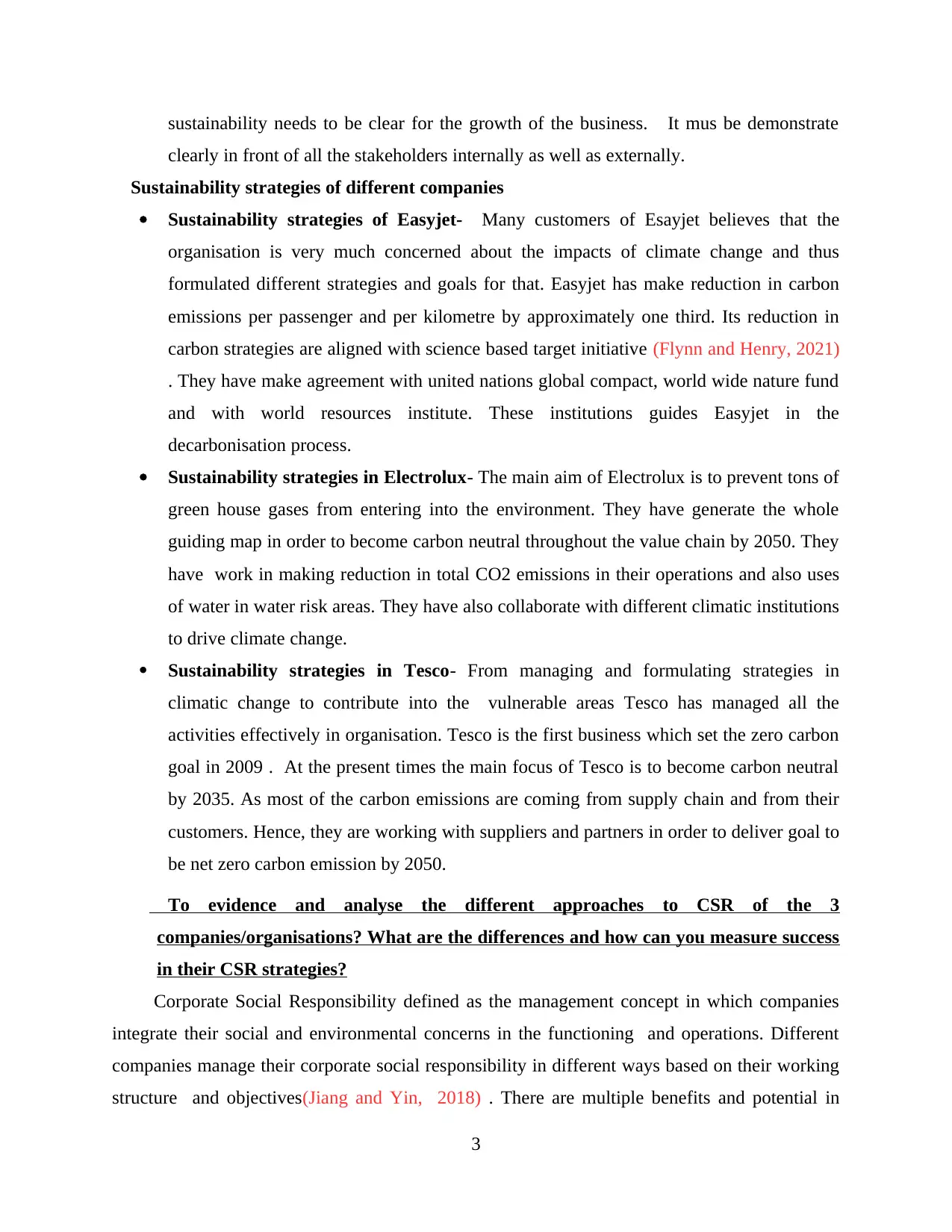
sustainability needs to be clear for the growth of the business. It mus be demonstrate
clearly in front of all the stakeholders internally as well as externally.
Sustainability strategies of different companies
Sustainability strategies of Easyjet- Many customers of Esayjet believes that the
organisation is very much concerned about the impacts of climate change and thus
formulated different strategies and goals for that. Easyjet has make reduction in carbon
emissions per passenger and per kilometre by approximately one third. Its reduction in
carbon strategies are aligned with science based target initiative (Flynn and Henry, 2021)
. They have make agreement with united nations global compact, world wide nature fund
and with world resources institute. These institutions guides Easyjet in the
decarbonisation process.
Sustainability strategies in Electrolux- The main aim of Electrolux is to prevent tons of
green house gases from entering into the environment. They have generate the whole
guiding map in order to become carbon neutral throughout the value chain by 2050. They
have work in making reduction in total CO2 emissions in their operations and also uses
of water in water risk areas. They have also collaborate with different climatic institutions
to drive climate change.
Sustainability strategies in Tesco- From managing and formulating strategies in
climatic change to contribute into the vulnerable areas Tesco has managed all the
activities effectively in organisation. Tesco is the first business which set the zero carbon
goal in 2009 . At the present times the main focus of Tesco is to become carbon neutral
by 2035. As most of the carbon emissions are coming from supply chain and from their
customers. Hence, they are working with suppliers and partners in order to deliver goal to
be net zero carbon emission by 2050.
To evidence and analyse the different approaches to CSR of the 3
companies/organisations? What are the differences and how can you measure success
in their CSR strategies?
Corporate Social Responsibility defined as the management concept in which companies
integrate their social and environmental concerns in the functioning and operations. Different
companies manage their corporate social responsibility in different ways based on their working
structure and objectives(Jiang and Yin, 2018) . There are multiple benefits and potential in
3
clearly in front of all the stakeholders internally as well as externally.
Sustainability strategies of different companies
Sustainability strategies of Easyjet- Many customers of Esayjet believes that the
organisation is very much concerned about the impacts of climate change and thus
formulated different strategies and goals for that. Easyjet has make reduction in carbon
emissions per passenger and per kilometre by approximately one third. Its reduction in
carbon strategies are aligned with science based target initiative (Flynn and Henry, 2021)
. They have make agreement with united nations global compact, world wide nature fund
and with world resources institute. These institutions guides Easyjet in the
decarbonisation process.
Sustainability strategies in Electrolux- The main aim of Electrolux is to prevent tons of
green house gases from entering into the environment. They have generate the whole
guiding map in order to become carbon neutral throughout the value chain by 2050. They
have work in making reduction in total CO2 emissions in their operations and also uses
of water in water risk areas. They have also collaborate with different climatic institutions
to drive climate change.
Sustainability strategies in Tesco- From managing and formulating strategies in
climatic change to contribute into the vulnerable areas Tesco has managed all the
activities effectively in organisation. Tesco is the first business which set the zero carbon
goal in 2009 . At the present times the main focus of Tesco is to become carbon neutral
by 2035. As most of the carbon emissions are coming from supply chain and from their
customers. Hence, they are working with suppliers and partners in order to deliver goal to
be net zero carbon emission by 2050.
To evidence and analyse the different approaches to CSR of the 3
companies/organisations? What are the differences and how can you measure success
in their CSR strategies?
Corporate Social Responsibility defined as the management concept in which companies
integrate their social and environmental concerns in the functioning and operations. Different
companies manage their corporate social responsibility in different ways based on their working
structure and objectives(Jiang and Yin, 2018) . There are multiple benefits and potential in
3
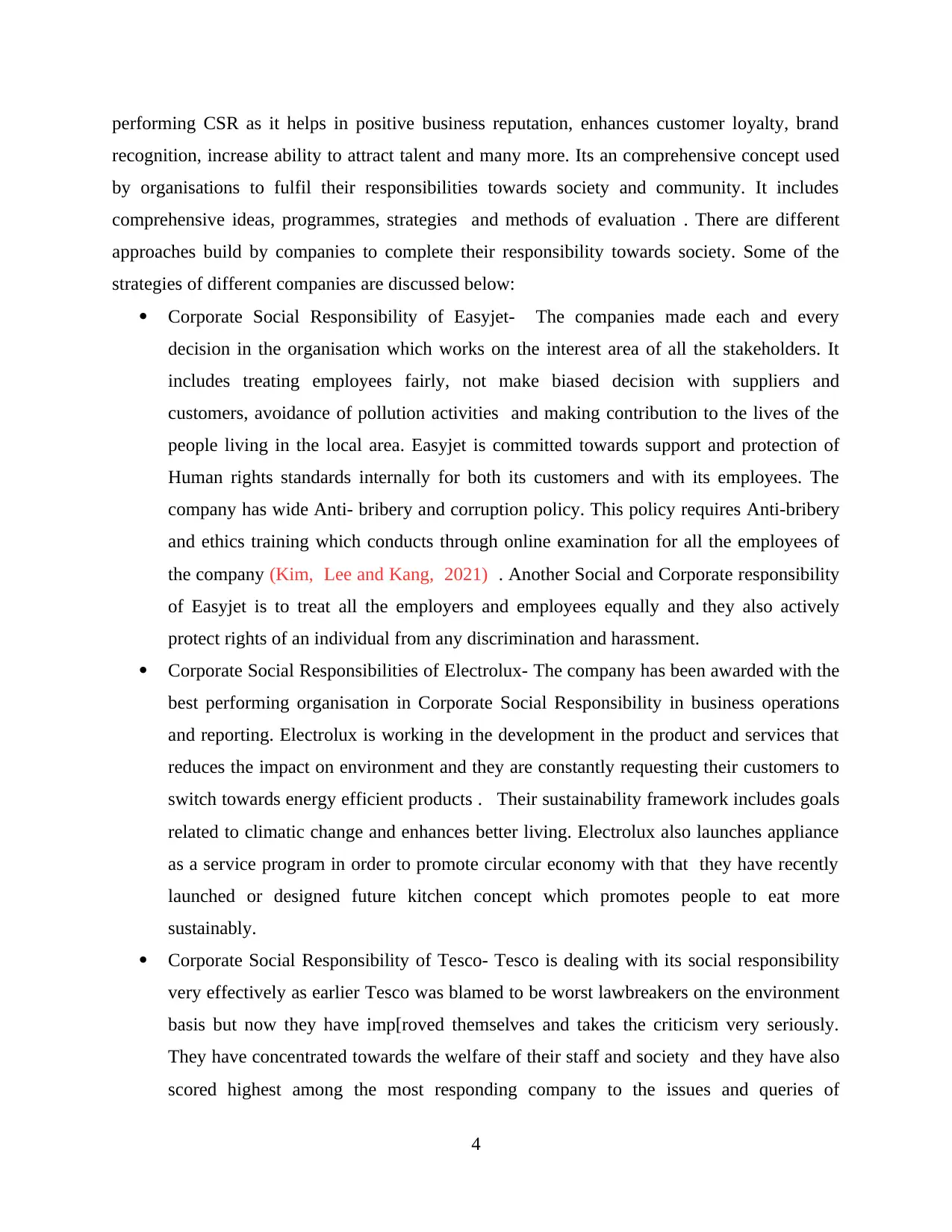
performing CSR as it helps in positive business reputation, enhances customer loyalty, brand
recognition, increase ability to attract talent and many more. Its an comprehensive concept used
by organisations to fulfil their responsibilities towards society and community. It includes
comprehensive ideas, programmes, strategies and methods of evaluation . There are different
approaches build by companies to complete their responsibility towards society. Some of the
strategies of different companies are discussed below:
Corporate Social Responsibility of Easyjet- The companies made each and every
decision in the organisation which works on the interest area of all the stakeholders. It
includes treating employees fairly, not make biased decision with suppliers and
customers, avoidance of pollution activities and making contribution to the lives of the
people living in the local area. Easyjet is committed towards support and protection of
Human rights standards internally for both its customers and with its employees. The
company has wide Anti- bribery and corruption policy. This policy requires Anti-bribery
and ethics training which conducts through online examination for all the employees of
the company (Kim, Lee and Kang, 2021) . Another Social and Corporate responsibility
of Easyjet is to treat all the employers and employees equally and they also actively
protect rights of an individual from any discrimination and harassment.
Corporate Social Responsibilities of Electrolux- The company has been awarded with the
best performing organisation in Corporate Social Responsibility in business operations
and reporting. Electrolux is working in the development in the product and services that
reduces the impact on environment and they are constantly requesting their customers to
switch towards energy efficient products . Their sustainability framework includes goals
related to climatic change and enhances better living. Electrolux also launches appliance
as a service program in order to promote circular economy with that they have recently
launched or designed future kitchen concept which promotes people to eat more
sustainably.
Corporate Social Responsibility of Tesco- Tesco is dealing with its social responsibility
very effectively as earlier Tesco was blamed to be worst lawbreakers on the environment
basis but now they have imp[roved themselves and takes the criticism very seriously.
They have concentrated towards the welfare of their staff and society and they have also
scored highest among the most responding company to the issues and queries of
4
recognition, increase ability to attract talent and many more. Its an comprehensive concept used
by organisations to fulfil their responsibilities towards society and community. It includes
comprehensive ideas, programmes, strategies and methods of evaluation . There are different
approaches build by companies to complete their responsibility towards society. Some of the
strategies of different companies are discussed below:
Corporate Social Responsibility of Easyjet- The companies made each and every
decision in the organisation which works on the interest area of all the stakeholders. It
includes treating employees fairly, not make biased decision with suppliers and
customers, avoidance of pollution activities and making contribution to the lives of the
people living in the local area. Easyjet is committed towards support and protection of
Human rights standards internally for both its customers and with its employees. The
company has wide Anti- bribery and corruption policy. This policy requires Anti-bribery
and ethics training which conducts through online examination for all the employees of
the company (Kim, Lee and Kang, 2021) . Another Social and Corporate responsibility
of Easyjet is to treat all the employers and employees equally and they also actively
protect rights of an individual from any discrimination and harassment.
Corporate Social Responsibilities of Electrolux- The company has been awarded with the
best performing organisation in Corporate Social Responsibility in business operations
and reporting. Electrolux is working in the development in the product and services that
reduces the impact on environment and they are constantly requesting their customers to
switch towards energy efficient products . Their sustainability framework includes goals
related to climatic change and enhances better living. Electrolux also launches appliance
as a service program in order to promote circular economy with that they have recently
launched or designed future kitchen concept which promotes people to eat more
sustainably.
Corporate Social Responsibility of Tesco- Tesco is dealing with its social responsibility
very effectively as earlier Tesco was blamed to be worst lawbreakers on the environment
basis but now they have imp[roved themselves and takes the criticism very seriously.
They have concentrated towards the welfare of their staff and society and they have also
scored highest among the most responding company to the issues and queries of
4

customers (Latif and Sajjad, 2018) . Tesco is focusing towards multiple issues in order to
complete their corporate social responsibility such as responsible use of technology,
using appropriate raw materials in the manufacturing process, conducting ethical trading,
conducting practises in relation to animal welfare and works in the welfare of their
employers, suppliers and customers.
There are multiple ways to analyse the effectiveness and success of corporate social
responsibility in the company, some of the measures are discussed below:
Measuring CSR by implementing targets- There is a need to implement targets first as
targets helps in measuring the work of the organisation. Targets helps in making
comparison of the work attain by the company.
Use KPIs to measure CSR performance- Every organisation should make long term ans
short term objectives as a benchmark in success. Key performance indicator should be
used as the stepping stones which as overall lead to achieve desired goals. Each
organisation has different capability to perform tasks and each company uses different
strategies in achieving objectives. In order to get help with developing CSR initiative's
there are few KPI performance indicator that a business can include in their performance
measurement such as satisfaction ratio, health ans security, employees perspectives,
quantity of waste generation, green house gas emissions, social contributions, recognition
achieved and many more.
Employees Recognised industry- standard measurements- There are several tools that can
be used in order to measure organisation development such as community mark, which
set national standards in community investment (Nave and Ferreira, 2019) . Then there
is B Corp Certification, which used to measure entire social and environmental
performance of the company. International Labour Organisation Supplier Framework
also uses as a tool to measure rights at the workplace.
5
complete their corporate social responsibility such as responsible use of technology,
using appropriate raw materials in the manufacturing process, conducting ethical trading,
conducting practises in relation to animal welfare and works in the welfare of their
employers, suppliers and customers.
There are multiple ways to analyse the effectiveness and success of corporate social
responsibility in the company, some of the measures are discussed below:
Measuring CSR by implementing targets- There is a need to implement targets first as
targets helps in measuring the work of the organisation. Targets helps in making
comparison of the work attain by the company.
Use KPIs to measure CSR performance- Every organisation should make long term ans
short term objectives as a benchmark in success. Key performance indicator should be
used as the stepping stones which as overall lead to achieve desired goals. Each
organisation has different capability to perform tasks and each company uses different
strategies in achieving objectives. In order to get help with developing CSR initiative's
there are few KPI performance indicator that a business can include in their performance
measurement such as satisfaction ratio, health ans security, employees perspectives,
quantity of waste generation, green house gas emissions, social contributions, recognition
achieved and many more.
Employees Recognised industry- standard measurements- There are several tools that can
be used in order to measure organisation development such as community mark, which
set national standards in community investment (Nave and Ferreira, 2019) . Then there
is B Corp Certification, which used to measure entire social and environmental
performance of the company. International Labour Organisation Supplier Framework
also uses as a tool to measure rights at the workplace.
5
Secure Best Marks with AI Grader
Need help grading? Try our AI Grader for instant feedback on your assignments.

6
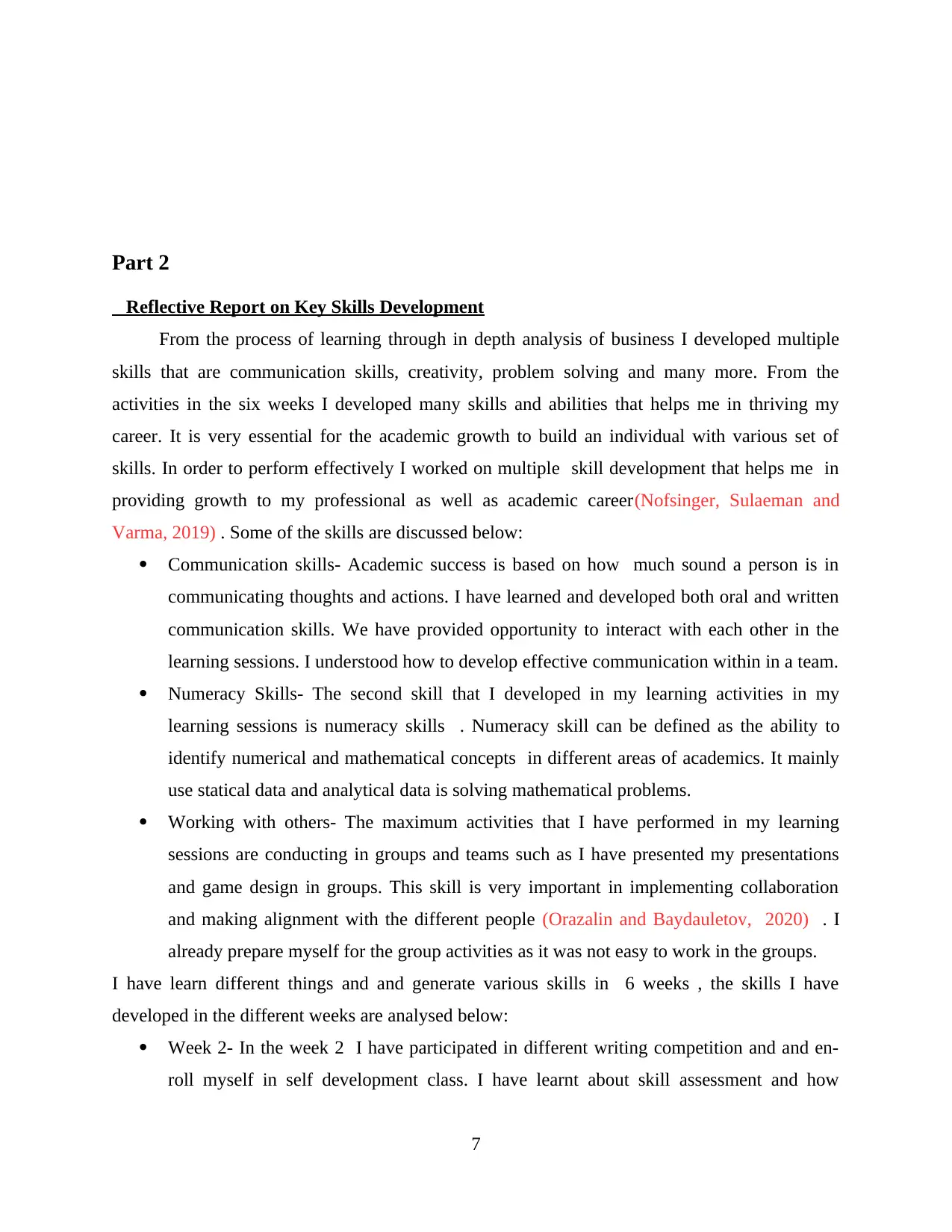
Part 2
Reflective Report on Key Skills Development
From the process of learning through in depth analysis of business I developed multiple
skills that are communication skills, creativity, problem solving and many more. From the
activities in the six weeks I developed many skills and abilities that helps me in thriving my
career. It is very essential for the academic growth to build an individual with various set of
skills. In order to perform effectively I worked on multiple skill development that helps me in
providing growth to my professional as well as academic career(Nofsinger, Sulaeman and
Varma, 2019) . Some of the skills are discussed below:
Communication skills- Academic success is based on how much sound a person is in
communicating thoughts and actions. I have learned and developed both oral and written
communication skills. We have provided opportunity to interact with each other in the
learning sessions. I understood how to develop effective communication within in a team.
Numeracy Skills- The second skill that I developed in my learning activities in my
learning sessions is numeracy skills . Numeracy skill can be defined as the ability to
identify numerical and mathematical concepts in different areas of academics. It mainly
use statical data and analytical data is solving mathematical problems.
Working with others- The maximum activities that I have performed in my learning
sessions are conducting in groups and teams such as I have presented my presentations
and game design in groups. This skill is very important in implementing collaboration
and making alignment with the different people (Orazalin and Baydauletov, 2020) . I
already prepare myself for the group activities as it was not easy to work in the groups.
I have learn different things and and generate various skills in 6 weeks , the skills I have
developed in the different weeks are analysed below:
Week 2- In the week 2 I have participated in different writing competition and and en-
roll myself in self development class. I have learnt about skill assessment and how
7
Reflective Report on Key Skills Development
From the process of learning through in depth analysis of business I developed multiple
skills that are communication skills, creativity, problem solving and many more. From the
activities in the six weeks I developed many skills and abilities that helps me in thriving my
career. It is very essential for the academic growth to build an individual with various set of
skills. In order to perform effectively I worked on multiple skill development that helps me in
providing growth to my professional as well as academic career(Nofsinger, Sulaeman and
Varma, 2019) . Some of the skills are discussed below:
Communication skills- Academic success is based on how much sound a person is in
communicating thoughts and actions. I have learned and developed both oral and written
communication skills. We have provided opportunity to interact with each other in the
learning sessions. I understood how to develop effective communication within in a team.
Numeracy Skills- The second skill that I developed in my learning activities in my
learning sessions is numeracy skills . Numeracy skill can be defined as the ability to
identify numerical and mathematical concepts in different areas of academics. It mainly
use statical data and analytical data is solving mathematical problems.
Working with others- The maximum activities that I have performed in my learning
sessions are conducting in groups and teams such as I have presented my presentations
and game design in groups. This skill is very important in implementing collaboration
and making alignment with the different people (Orazalin and Baydauletov, 2020) . I
already prepare myself for the group activities as it was not easy to work in the groups.
I have learn different things and and generate various skills in 6 weeks , the skills I have
developed in the different weeks are analysed below:
Week 2- In the week 2 I have participated in different writing competition and and en-
roll myself in self development class. I have learnt about skill assessment and how
7
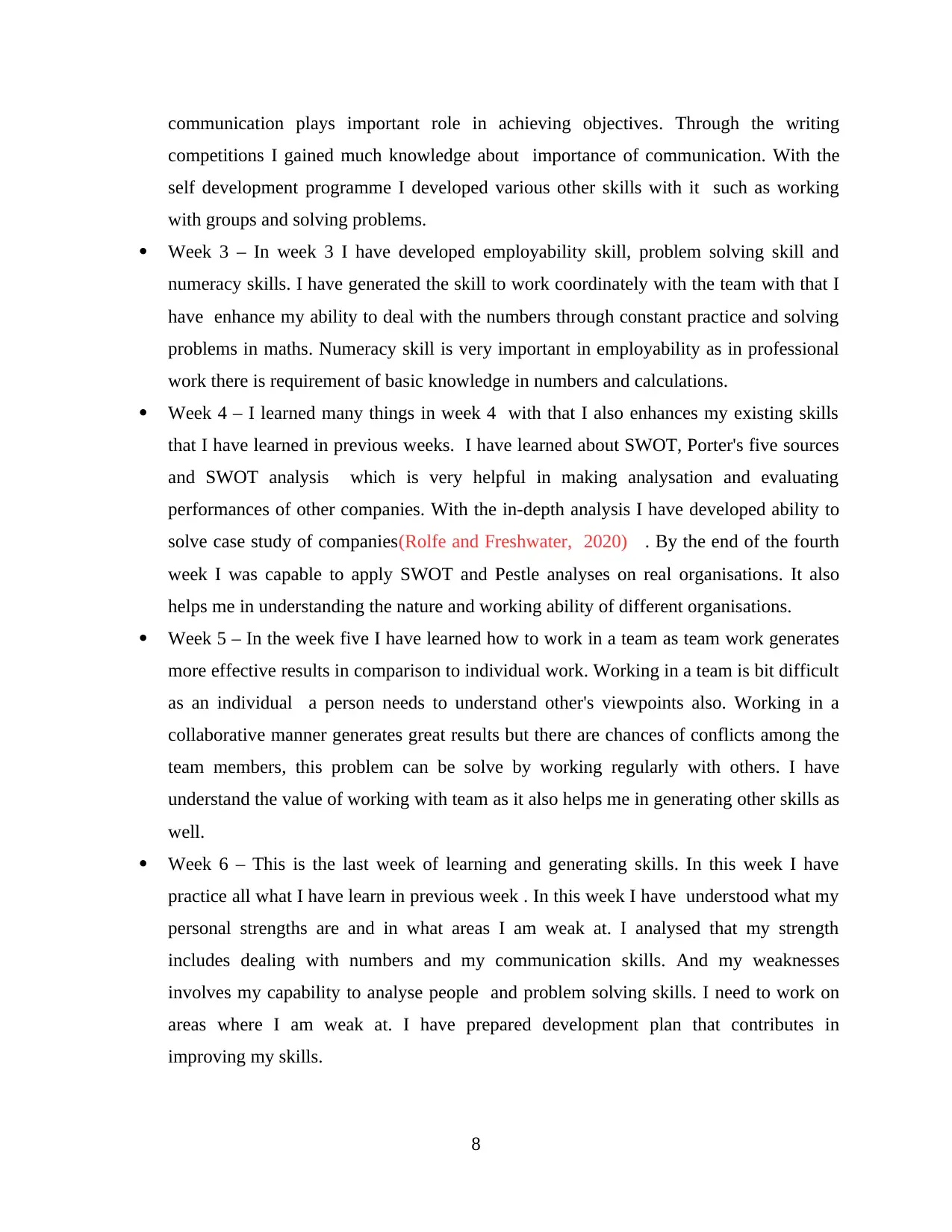
communication plays important role in achieving objectives. Through the writing
competitions I gained much knowledge about importance of communication. With the
self development programme I developed various other skills with it such as working
with groups and solving problems.
Week 3 – In week 3 I have developed employability skill, problem solving skill and
numeracy skills. I have generated the skill to work coordinately with the team with that I
have enhance my ability to deal with the numbers through constant practice and solving
problems in maths. Numeracy skill is very important in employability as in professional
work there is requirement of basic knowledge in numbers and calculations.
Week 4 – I learned many things in week 4 with that I also enhances my existing skills
that I have learned in previous weeks. I have learned about SWOT, Porter's five sources
and SWOT analysis which is very helpful in making analysation and evaluating
performances of other companies. With the in-depth analysis I have developed ability to
solve case study of companies(Rolfe and Freshwater, 2020) . By the end of the fourth
week I was capable to apply SWOT and Pestle analyses on real organisations. It also
helps me in understanding the nature and working ability of different organisations.
Week 5 – In the week five I have learned how to work in a team as team work generates
more effective results in comparison to individual work. Working in a team is bit difficult
as an individual a person needs to understand other's viewpoints also. Working in a
collaborative manner generates great results but there are chances of conflicts among the
team members, this problem can be solve by working regularly with others. I have
understand the value of working with team as it also helps me in generating other skills as
well.
Week 6 – This is the last week of learning and generating skills. In this week I have
practice all what I have learn in previous week . In this week I have understood what my
personal strengths are and in what areas I am weak at. I analysed that my strength
includes dealing with numbers and my communication skills. And my weaknesses
involves my capability to analyse people and problem solving skills. I need to work on
areas where I am weak at. I have prepared development plan that contributes in
improving my skills.
8
competitions I gained much knowledge about importance of communication. With the
self development programme I developed various other skills with it such as working
with groups and solving problems.
Week 3 – In week 3 I have developed employability skill, problem solving skill and
numeracy skills. I have generated the skill to work coordinately with the team with that I
have enhance my ability to deal with the numbers through constant practice and solving
problems in maths. Numeracy skill is very important in employability as in professional
work there is requirement of basic knowledge in numbers and calculations.
Week 4 – I learned many things in week 4 with that I also enhances my existing skills
that I have learned in previous weeks. I have learned about SWOT, Porter's five sources
and SWOT analysis which is very helpful in making analysation and evaluating
performances of other companies. With the in-depth analysis I have developed ability to
solve case study of companies(Rolfe and Freshwater, 2020) . By the end of the fourth
week I was capable to apply SWOT and Pestle analyses on real organisations. It also
helps me in understanding the nature and working ability of different organisations.
Week 5 – In the week five I have learned how to work in a team as team work generates
more effective results in comparison to individual work. Working in a team is bit difficult
as an individual a person needs to understand other's viewpoints also. Working in a
collaborative manner generates great results but there are chances of conflicts among the
team members, this problem can be solve by working regularly with others. I have
understand the value of working with team as it also helps me in generating other skills as
well.
Week 6 – This is the last week of learning and generating skills. In this week I have
practice all what I have learn in previous week . In this week I have understood what my
personal strengths are and in what areas I am weak at. I analysed that my strength
includes dealing with numbers and my communication skills. And my weaknesses
involves my capability to analyse people and problem solving skills. I need to work on
areas where I am weak at. I have prepared development plan that contributes in
improving my skills.
8
Paraphrase This Document
Need a fresh take? Get an instant paraphrase of this document with our AI Paraphraser

Objective Time Period Action Plan Evaluating Parameters
Problem-
Solving skills
2 months The action taken for enhancing my
problem solving skills is to learn
about different reasoning methods
with reasoning(Suchman and Trigg,
2020). This will help in
improvement in problem solving
skills.
The primary parameter for
evaluating improvement in
problem solving skills is to
understand improvement in
analytical abilities.
Understandin
g people and
their
viewpoints.
3 months This skill can be developed by
participating in team activities and
leaning about their viewpoints.
This skill can be measured
by understanding and
working without any
conflicts in team.
9
Problem-
Solving skills
2 months The action taken for enhancing my
problem solving skills is to learn
about different reasoning methods
with reasoning(Suchman and Trigg,
2020). This will help in
improvement in problem solving
skills.
The primary parameter for
evaluating improvement in
problem solving skills is to
understand improvement in
analytical abilities.
Understandin
g people and
their
viewpoints.
3 months This skill can be developed by
participating in team activities and
leaning about their viewpoints.
This skill can be measured
by understanding and
working without any
conflicts in team.
9
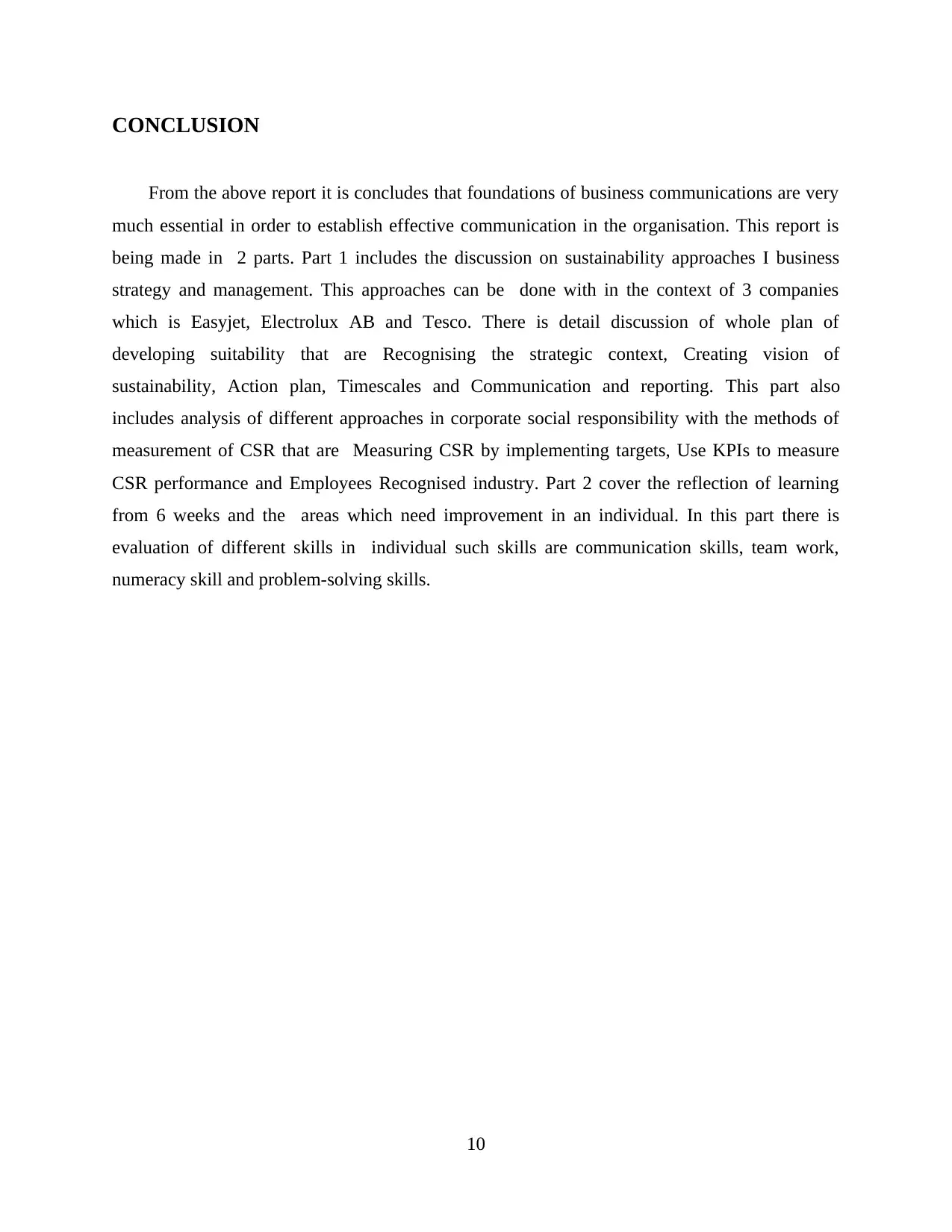
CONCLUSION
From the above report it is concludes that foundations of business communications are very
much essential in order to establish effective communication in the organisation. This report is
being made in 2 parts. Part 1 includes the discussion on sustainability approaches I business
strategy and management. This approaches can be done with in the context of 3 companies
which is Easyjet, Electrolux AB and Tesco. There is detail discussion of whole plan of
developing suitability that are Recognising the strategic context, Creating vision of
sustainability, Action plan, Timescales and Communication and reporting. This part also
includes analysis of different approaches in corporate social responsibility with the methods of
measurement of CSR that are Measuring CSR by implementing targets, Use KPIs to measure
CSR performance and Employees Recognised industry. Part 2 cover the reflection of learning
from 6 weeks and the areas which need improvement in an individual. In this part there is
evaluation of different skills in individual such skills are communication skills, team work,
numeracy skill and problem-solving skills.
10
From the above report it is concludes that foundations of business communications are very
much essential in order to establish effective communication in the organisation. This report is
being made in 2 parts. Part 1 includes the discussion on sustainability approaches I business
strategy and management. This approaches can be done with in the context of 3 companies
which is Easyjet, Electrolux AB and Tesco. There is detail discussion of whole plan of
developing suitability that are Recognising the strategic context, Creating vision of
sustainability, Action plan, Timescales and Communication and reporting. This part also
includes analysis of different approaches in corporate social responsibility with the methods of
measurement of CSR that are Measuring CSR by implementing targets, Use KPIs to measure
CSR performance and Employees Recognised industry. Part 2 cover the reflection of learning
from 6 weeks and the areas which need improvement in an individual. In this part there is
evaluation of different skills in individual such skills are communication skills, team work,
numeracy skill and problem-solving skills.
10
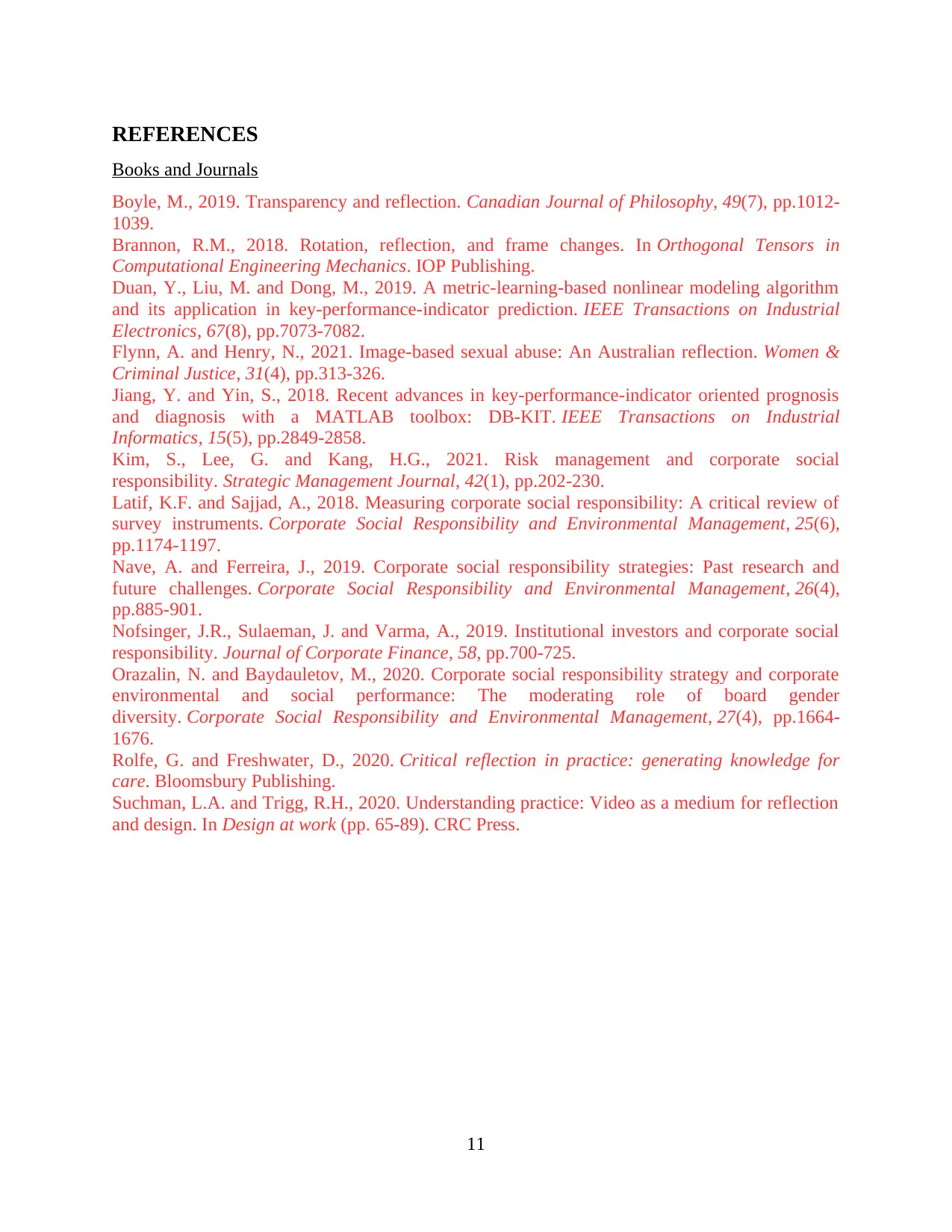
REFERENCES
Books and Journals
Boyle, M., 2019. Transparency and reflection. Canadian Journal of Philosophy, 49(7), pp.1012-
1039.
Brannon, R.M., 2018. Rotation, reflection, and frame changes. In Orthogonal Tensors in
Computational Engineering Mechanics. IOP Publishing.
Duan, Y., Liu, M. and Dong, M., 2019. A metric-learning-based nonlinear modeling algorithm
and its application in key-performance-indicator prediction. IEEE Transactions on Industrial
Electronics, 67(8), pp.7073-7082.
Flynn, A. and Henry, N., 2021. Image-based sexual abuse: An Australian reflection. Women &
Criminal Justice, 31(4), pp.313-326.
Jiang, Y. and Yin, S., 2018. Recent advances in key-performance-indicator oriented prognosis
and diagnosis with a MATLAB toolbox: DB-KIT. IEEE Transactions on Industrial
Informatics, 15(5), pp.2849-2858.
Kim, S., Lee, G. and Kang, H.G., 2021. Risk management and corporate social
responsibility. Strategic Management Journal, 42(1), pp.202-230.
Latif, K.F. and Sajjad, A., 2018. Measuring corporate social responsibility: A critical review of
survey instruments. Corporate Social Responsibility and Environmental Management, 25(6),
pp.1174-1197.
Nave, A. and Ferreira, J., 2019. Corporate social responsibility strategies: Past research and
future challenges. Corporate Social Responsibility and Environmental Management, 26(4),
pp.885-901.
Nofsinger, J.R., Sulaeman, J. and Varma, A., 2019. Institutional investors and corporate social
responsibility. Journal of Corporate Finance, 58, pp.700-725.
Orazalin, N. and Baydauletov, M., 2020. Corporate social responsibility strategy and corporate
environmental and social performance: The moderating role of board gender
diversity. Corporate Social Responsibility and Environmental Management, 27(4), pp.1664-
1676.
Rolfe, G. and Freshwater, D., 2020. Critical reflection in practice: generating knowledge for
care. Bloomsbury Publishing.
Suchman, L.A. and Trigg, R.H., 2020. Understanding practice: Video as a medium for reflection
and design. In Design at work (pp. 65-89). CRC Press.
11
Books and Journals
Boyle, M., 2019. Transparency and reflection. Canadian Journal of Philosophy, 49(7), pp.1012-
1039.
Brannon, R.M., 2018. Rotation, reflection, and frame changes. In Orthogonal Tensors in
Computational Engineering Mechanics. IOP Publishing.
Duan, Y., Liu, M. and Dong, M., 2019. A metric-learning-based nonlinear modeling algorithm
and its application in key-performance-indicator prediction. IEEE Transactions on Industrial
Electronics, 67(8), pp.7073-7082.
Flynn, A. and Henry, N., 2021. Image-based sexual abuse: An Australian reflection. Women &
Criminal Justice, 31(4), pp.313-326.
Jiang, Y. and Yin, S., 2018. Recent advances in key-performance-indicator oriented prognosis
and diagnosis with a MATLAB toolbox: DB-KIT. IEEE Transactions on Industrial
Informatics, 15(5), pp.2849-2858.
Kim, S., Lee, G. and Kang, H.G., 2021. Risk management and corporate social
responsibility. Strategic Management Journal, 42(1), pp.202-230.
Latif, K.F. and Sajjad, A., 2018. Measuring corporate social responsibility: A critical review of
survey instruments. Corporate Social Responsibility and Environmental Management, 25(6),
pp.1174-1197.
Nave, A. and Ferreira, J., 2019. Corporate social responsibility strategies: Past research and
future challenges. Corporate Social Responsibility and Environmental Management, 26(4),
pp.885-901.
Nofsinger, J.R., Sulaeman, J. and Varma, A., 2019. Institutional investors and corporate social
responsibility. Journal of Corporate Finance, 58, pp.700-725.
Orazalin, N. and Baydauletov, M., 2020. Corporate social responsibility strategy and corporate
environmental and social performance: The moderating role of board gender
diversity. Corporate Social Responsibility and Environmental Management, 27(4), pp.1664-
1676.
Rolfe, G. and Freshwater, D., 2020. Critical reflection in practice: generating knowledge for
care. Bloomsbury Publishing.
Suchman, L.A. and Trigg, R.H., 2020. Understanding practice: Video as a medium for reflection
and design. In Design at work (pp. 65-89). CRC Press.
11
1 out of 13
Related Documents
Your All-in-One AI-Powered Toolkit for Academic Success.
+13062052269
info@desklib.com
Available 24*7 on WhatsApp / Email
![[object Object]](/_next/static/media/star-bottom.7253800d.svg)
Unlock your academic potential
© 2024 | Zucol Services PVT LTD | All rights reserved.




